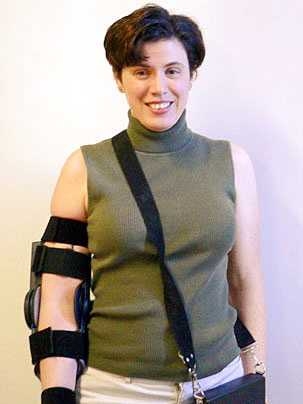At age 32, Maggie Fermental suffered a stroke that left her right side paralyzed. After a year and a half of conventional therapy with minimal results, she tried a new kind of robotic therapy developed by MIT engineers. A study to appear in the April 2007 issue of the American Journal of Physical Medicine & Rehabilitation shows that the device, which helped Fermental, also had positive results for five other severe stroke patients in a pilot clinical trial.
Fermental, a former surgical nurse, used the rehabilitation device 18 times over nine weeks. After 16 sessions, Fermental, now a stroke education nurse at Beth Israel Hospital, was able to fully bend and straighten her elbow on her own for the first time since the stroke. "It was incredible to be able to move my arm again on command," she said. "Cooking, dressing, shopping, turning on light switches, opening cabinets--it's easier now that I have two arms again."
The device--which sensed Fermental's electrical muscle activity and provided power assistance to facilitate her movements--also altered her brain.
Following a stroke, the destruction of brain cells leads to loss of motor function. With painstakingly repetitive exercise therapy, other neurons can take over some of the lost function. Devices such as the MIT-developed robotic brace can help people exploit their neural plasticity--the increasingly recognized ability of the brain to rewire itself in response to experience and training.
The robotic therapy device, which is awaiting FDA approval, was tested on stroke patients at MIT's Clinical Research Center and at Spaulding Rehabilitation Hospital in Boston. According to the researchers, the results show that "the ability of the device to provide a 'power assist' to … muscle groups may help close the feedback loop of brain intention and actual limb movement that is believed to be a key component of cerebral plasticity in motor recovery."
The study showed that the severely impaired patients' arm function improved, on average, 23 percent after using the brace, and the arm muscle tightness typical of stroke victims was significantly reduced.
Cost-effective rehabilitation
In the United States, there are 5.7 million stroke survivors and 700,000 new cases per year. Stroke is the single leading cause of disability in the United States. Many of the medical devices aimed at treating patients afflicted with neurological disorders have not fundamentally changed in decades, or require costly, high-risk brain implants.
The robotic therapy device was one of the first recipients of a grant from MIT's Deshpande Center for Technological Innovation. The center funds novel early-stage research and connects MIT's innovators with the resources needed to increase their commercial viability. The robotic therapy device received Deshpande grants in 2002 and 2003.
"We saw this as a novel technology with the potential to have a significant impact on the quality of life for people," said Charles Cooney, faculty director of the Deshpande Center and a professor in the Department of Chemical Engineering. "This study proves we were right."
The wearable, portable, lightweight robotic brace slides onto the arm. By sensing the patient's electrical muscle activity through electromyography (EMG)--which detects muscle cells' electrical activity when they contract--and sending that data to a motor, it allows stroke patients to control their affected limbs.
When used under the supervision of an occupational or physical therapist, the device can be used to help patients progress from basic motor training, such as lifting boxes or reaching for a light switch, to more complex tasks such as carrying a laundry basket or flipping a light on and off while holding an object with the unaffected limb.
According to the study researchers--Dr. Joel Stein, Kathryn Krebs and Richard Hughes of Harvard Medical School and Spaulding Rehabilitation Hospital and MIT graduates Kailas Narendran and John McBean--even people who have experienced a stroke years ago may be able to use the device to regain mobility.
"This brace will allow people who have suffered from neurological trauma to rebuild strength, rehabilitate and gain independence," said Woodie Flowers, Pappalardo Professor of Mechanical Engineering at MIT, who led the original research team that developed the device. "The joint brace is easily controlled by the user and appears to be cost-effective. It could afford self-driven therapy for a large patient population."
Relearning how to move
In 2002 and 2003, Flowers, along with then-students Narendran and McBean, developed a working prototype of the active joint brace. The first prototype system enabled paralyzed victims with certain kinds of spinal cord injuries to move their arms. In 2004, Narendran and McBean won the MIT $50K business plan competition and shortly afterward started the Boston-based company Myomo (an acronym for "my own motion") to develop a new class of medical technology they call NeuroRobotics.
"NeuroRobotics noninvasively helps people suffering from neurological trauma regain mobility by facilitating their ability to relearn how to control affected muscles and neurological pathways," Narendran said.
"Unlike other systems that stimulate or move the muscle for a patient, NeuroRobotics is embedded in lightweight wearable devices that actually adjust to a person's body and use the person's own electrical muscle activity signal to initiate and control movement," McBean said.
"Without the device, many of the individuals we tested were simply unable to complete the movement, and thus had no practical way to improve their performance through practice," Stein said. "By allowing the user to complete an intended movement through its 'power assist' function, the device helps the user improve his or her performance through practice. Thus the device acts as a facilitator of the innate capability of the human brain to improve function through practice."
A version of this article appeared in MIT Tech Talk on March 21, 2007 (download PDF).






